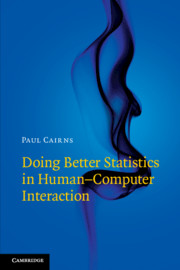Book contents
- Frontmatter
- Dedication
- Contents
- Figures
- Tables
- Acknowledgements
- Getting Started
- Part I Why We Use Statistics
- Part II How to Use Statistics
- 5 Planning Your Statistical Analysis
- 6 A Cautionary Tail: Why You Should Not Do a One-Tailed Test
- 7 Is This Normal?
- 8 Sorting Out Outliers
- 9 Power and Two Types of Error
- 10 Using Non-Parametric Tests
- 11 A Robust t-Test
- 12 The ANOVA Family and Friends
- 13 Exploring, Over-Testing and Fishing
- 14 When Is a Correlation Not a Correlation?
- 15 What Makes a Good Likert Item?
- 16 The Meaning of Factors
- 17 Unreliable Reliability: The Problem of Cronbach’s Alpha
- 18 Tests for Questionnaires
- Index
6 - A Cautionary Tail: Why You Should Not Do a One-Tailed Test
from Part II - How to Use Statistics
Published online by Cambridge University Press: 26 January 2019
- Frontmatter
- Dedication
- Contents
- Figures
- Tables
- Acknowledgements
- Getting Started
- Part I Why We Use Statistics
- Part II How to Use Statistics
- 5 Planning Your Statistical Analysis
- 6 A Cautionary Tail: Why You Should Not Do a One-Tailed Test
- 7 Is This Normal?
- 8 Sorting Out Outliers
- 9 Power and Two Types of Error
- 10 Using Non-Parametric Tests
- 11 A Robust t-Test
- 12 The ANOVA Family and Friends
- 13 Exploring, Over-Testing and Fishing
- 14 When Is a Correlation Not a Correlation?
- 15 What Makes a Good Likert Item?
- 16 The Meaning of Factors
- 17 Unreliable Reliability: The Problem of Cronbach’s Alpha
- 18 Tests for Questionnaires
- Index
Summary
A directional hypothesis predicts the specific way in which data are affected by an experimental manipulation. This, therefore, fits well with severe testing by making a concrete, explicit prediction. However, one-tailed testing associated with directional hypotheses regularly receives criticism because it can look like a way to make it easy to achieve statistical significance. This chapter describes why this is a problem and makes the case that despite the fit with severe testing, two-tailed testing is still the better way to do statistical analysis.
- Type
- Chapter
- Information
- Doing Better Statistics in Human-Computer Interaction , pp. 80 - 85Publisher: Cambridge University PressPrint publication year: 2019

